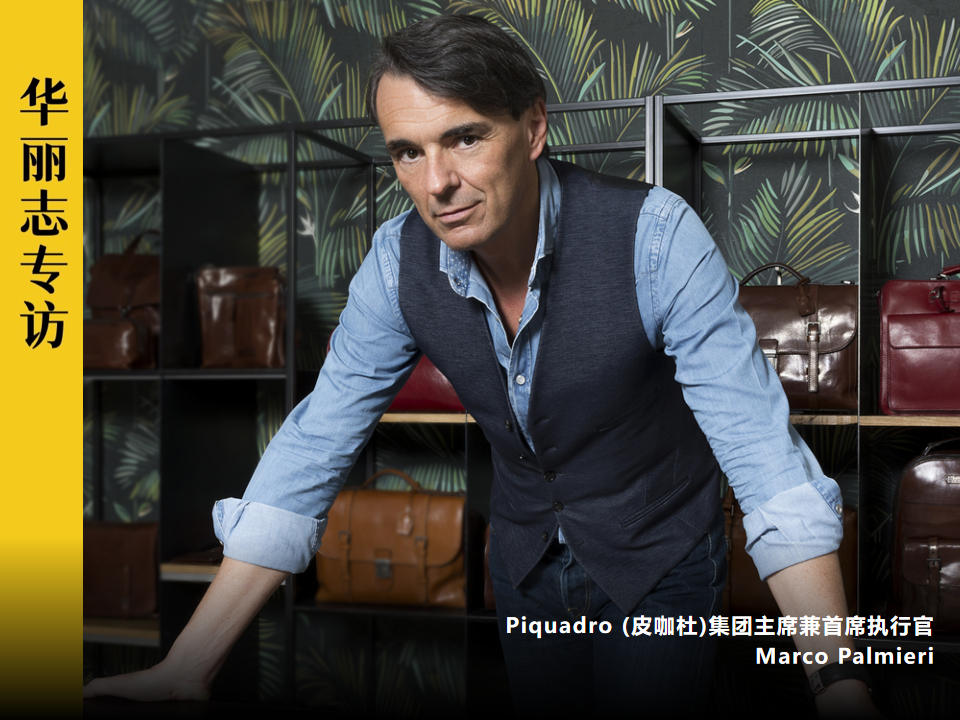Recently, the Italian luxury jewelry brand Buccellati unveiled a new boutique and a brand art exhibition at the MGM Hotel in Macau, China. Luxeplace.com was invited to attend the event and exclusively interviewed Andrea Buccellati and Luca Buccellati, the third-generation family members of Buccellati.
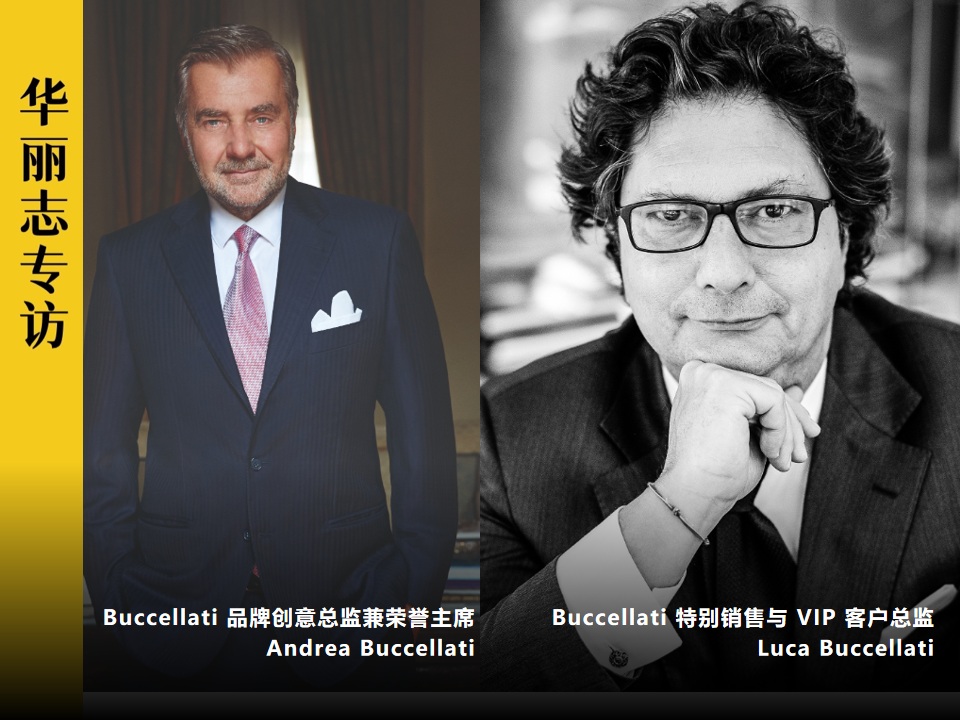
Andrea (left) and Luca (right), cousins, are still deeply involved in the management of the Buccellati brand. Andrea serves as the brand’s Creative Director and Honorary Chairman, while Luca is the Director of Special Sales and VIP Customers.
During the interview, both Andrea and Luca emphasized that, despite joining the Kering Group, Buccellati remains a family business, with the Buccellati family still 100% involved in all aspects of the brand. This, they believe, is what makes the brand unique in the high-end jewelry sector.
In this interview, they also shared their thoughts on the China market, brand heritage, and the training of artisanal talents.
- A Four-Generation Family Business: “Customers Can Call Me Straight”
- “Everybody Says (China is) a New Market, but My Opinion It Is Not”
- “VIP Customers in China are Different; They Know Exactly What They Want”
- “I Design for Women, My Daughter Designs for Herself”
- “Everyone Used to Aspire to Work in Banking, Internet; Now Young People are Eager to Know About Craftmanship”
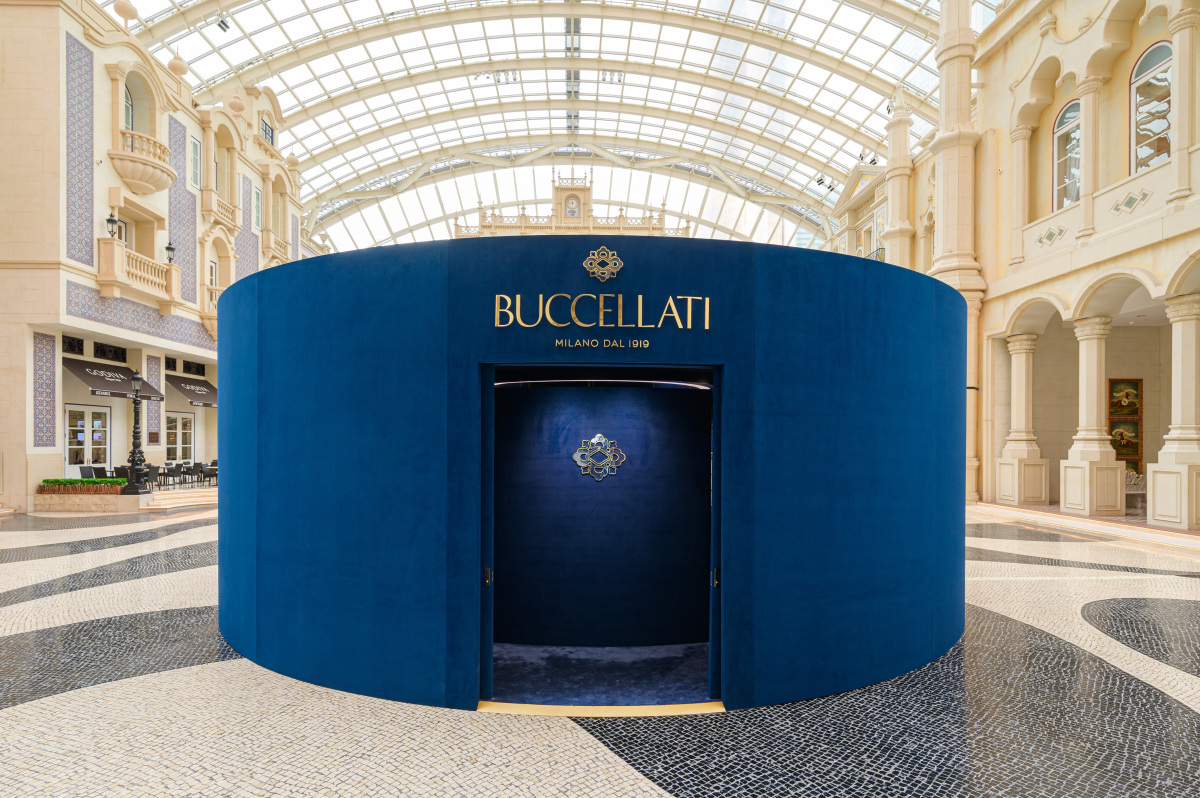
Buccellati hosts a “Timeless Beauty with Century-Old Craftmanship” art appreciation exhibition in Macau, China.
A Four-Generation Family Business: “Customers Can Call Me Straight”
Founded in 1919 by Mario Buccellati, known as the “Prince of Goldsmiths,” Buccellati is proud of its exquisite jewelry craftsmanship. Mario introduced a Renaissance-era goldsmithing technique called “Texture Engraving,” which creates delicate, lace-like patterns on gold and silver pieces. This technique is still used in the family workshop today.
Under the second-generation heir, Gianmaria (Andrea’s father), Buccellati was transformed into a top-tier global jewelry brand. In 2019, the Swiss luxury conglomerate Richemont Group acquired Buccellati.
Although Buccellati only entered the Chinese mainland market in 2017 and started expanding rapidly after 2020, Luca told Luxeplace.com that China is now one of Buccellati’s largest markets.
In the high-end jewelry sector, Buccellati is one of the few brands that has never employed external designers for its jewelry designs. The creative work, from founder Mario to Gianmaria, to the third generation’s Andrea, and the fourth generation’s Lucrezia, has always been controlled within the family.
Since 2013, Andrea’s daughter Lucrezia has been actively involved in creating new jewelry collections, making her the first female jewelry designer in Buccellati’s history.

A group photo of the Buccellati family members, from left to right: Lucrezia Buccellati, Andrea Buccellati, Maria Cristina Buccellati, Luca Buccellati.
Each piece of Buccellati’s work is unique, embodying the immense patience and passion of its craftsmen. For example, the brand’s signature honeycomb pattern design requires artisans to meticulously carve every tiny hole in the metal, a process that can take weeks or months.
Therefore, increasing production capacity has always been a challenge for Buccellati. Andrea told Luxeplace.com that training an artisan to meet Buccellati’s high standards takes 6 to 7 years. This is a significant, long-term investment for Buccellati but an essential one, as artisans are the core of the brand.
In 2021, Buccellati partnered with the Scuola Orafa Ambrosiana (SOA) in Milan to establish the Accademia Buccellati, heavily investing in the training of young artisanal talents.
Outside of work, Luca excitedly shared that he and other Buccellati family members love to play golf. Additionally, he is a “rock veteran” with his own rock band, where he plays the drums.
Below is the transcript of the interview:
Luxeplace.com: Could you describe Buccellati with three key words?
Luca: Heritage, Handmade, Luxury.
Luxeplace.com: What makes Buccellati unique in the high-end jewelry sector?
Luca: The Buccellati family is still 100% involved in production style and all aspects of the brand. So we the family decide what to do, we decide which collection we make. We are very clear about the preferences of consumers in different countries and can offer them different products accordingly.
I have the contacts of many VIP customers in China, and they can call me straight to inquire about various products. They trust me a lot. In fact, we are one of the few brands where customers can directly converse with family members.
Andrea: Today, no other (well-known) jewelry brand has so many family members involved in its operation like Buccellati, which is what makes us unique.
This means customers can come directly to me, we can sit down and talk about the design they want, and then I will create a unique piece of jewelry for them. If you go to other jewelry brands, this is almost impossible.
Luxeplace.com: Has Buccellati changed after being acquired by Richemont Group?
Andrea: In terms of design, style, production, quality of production, there have been no changes in Buccellati. The changes brought about by Richemont Group are only in organization, logistics, system, IT.
I am actually very happy that Buccellati has joined Richemont Group because they are truly partners who can help us grow in the manner of a family business. They do not care about short-term profits but focus more on what Buccellati will be like in the next 20 years or even longer.
Luca: After joining Richemont Group, our budget for advertising and promotion increased, giving us more options to increase the brand’s exposure. However, in terms of products, we have remained unchanged, sticking to handmade craftsmanship.

Buccellati Opera Tulle series works
“Everybody Says (China is) a New Market, but My Opinion It Is Not “
Luxeplace.com: Compared to other high-end jewelry brands, Buccellati entered the Chinese market relatively late. Has this posed challenges for the brand’s development in China?
Luca: I’d like to share a little story. When I was young, my father told me, “If you go to Place Vendôme in Paris and pick a piece of jewelry from each brand’s window, mix them with Buccellati’s jewelry in a bag, shuffle them, and then pour them onto a table, you will recognize Buccellati’s jewelry immediately.”
That’s the power of the Buccellati brand. We are completely different in terms of craftsmanship, taste, and design. Also, due to Chinese consumers’ preference for gold, they can more accurately perceive these differences and find the parts that are truly meaningful to them. This is what I understand to be the reason why they choose Buccellati.
Luxeplace.com: What is the status of the Chinese market in Buccellati’s global strategy?
Luca: The Chinese market is currently one of our largest markets.
Currently, Buccellati has 10 boutiques and 1 pop-up store in mainland China. We plan to open another 3-4 stores. Once we reach a certain number, we will pause our store expansion plan. This is partly due to production capacity and partly because we want to maintain Buccellati’s tone.
Even though many customers have to wait for several months or even a year to get Buccellati’s pieces, they are still very happy.
Luxeplace.com: What is the age group of Buccellati’s core clientele in China?
Luca: The core customer group is now younger than before, above 30 years old. Thanks to the launch of the new Opera series, which is very popular among the younger crowd.
Buccellati’s Chinese customers are generally younger than our European customers. Although we have made some adjustments in Europe in recent years to attract a younger demographic, it is much more difficult than in China.
Although everyone says China is a new market, but my opinion is that it is not a new market. China has thousands of years of history, and people easily resonate with a brand like Buccellati that has a long history and heritage of craftsmanship.
Actually, I don’t really like to use the word “customers” to refer to Buccellati’s clients. I prefer to call them “friends.” In my eyes, there is no difference between friends who spend millions of euros and those who spend a few thousand euros at Buccellati. I always hope to keep in touch with them.

The newly opened Buccellati boutique in Haitang Bay, Sanya.
In November 2017, Buccellati first entered the Chinese mainland market, opening its first boutique in Shanghai’s Plaza 66. Today, Buccellati has 10 boutiques and 1 pop-up store in mainland China, located in Beijing, Shanghai, Shenzhen, Nanjing, Hangzhou, Chengdu, and Sanya.
“VIP Customers in China are Different; They Know Exactly What They Want”
Luxeplace.com: In dealing with VIP customers globally, what differences have you found between Chinese customers and those from other markets?
Luca: VIP customers in China are very different. They know exactly what they want, they want heritage they want history, they want handmade pieces. They also really love the fact that Buccellati has always maintained its status as a family company.
Andrea: When Buccellati first entered China, I was surprised by the cultural awareness of young Chinese consumers. They even knew more about the brand’s historical details than I did!
For instance, once at a dinner in Beijing with Buccellati customers, I was seated next to a young man in his twenties who talked to me about the Buccellati family’s story, from my grandfather to my father. I was so surprised and asked him where he learned all this. He replied, “Because before that I buy a piece of jewelry, I will study, I go on the internet and I read everything about the story, because I want to know when I buy a piece is what is the history in the back of this (brand).”
Luxeplace.com: What do you think is key to enhancing VIP customer loyalty and brand fidelity?
Luca: Understanding their preferences accurately and providing them with what they want. Especially in China, each of our boutiques has a VIP-exclusive area.

The interior space of the Buccellati boutique in Haitang Bay, Sanya.
Luxeplace.com: How do you think jewelry brands should communicate with young Chinese consumers?
Luca: We plan to host many events in China in 2024 and 2025. I will also frequently visit China to have dinner with customers and show them new collections. I love China; it’s one of my favorite countries.
“I Design for Women, My Daughter Designs for Herself”
Luxeplace.com: What does the family’s continuation of creative design work mean for the brand?
Andrea: Heritage is the foundation of Buccellati. The reason we can maintain our traditions, recognizability, and uniqueness of style is because all our designers are family members. These design concepts, craftsmanship, and quality are rooted in our upbringing.
My daughter once studied design in New York. Her teacher told her, “Your designs always have Buccellati’s shadow. You should try different styles.” But my daughter responded, “No, this is part of me; I grew up with this.”
It’s very important that we pass from generation to generation this concept of the design and the creativity because they keep the quality. You keep the style, unique, unchangeable. You do the Buccellati style.
Luxeplace.com: As the first female designer in Buccellati’s history, what new perspectives has your daughter brought to the brand?
Andrea: When I design a jewelry for a woman, I imagine a beautiful woman, a beautiful design, beautiful pieces, et cetera.
But Lucrezia has a different prosperity. She thinks about herself, so she said I want to design something that I can wear easily. It’s something that I can wear every day. If I go to take my kids to the school, I want to have a piece of jewelry that i’m comfortable.
In short, I design for others; she designs for herself. That’s the new perspective she brings.
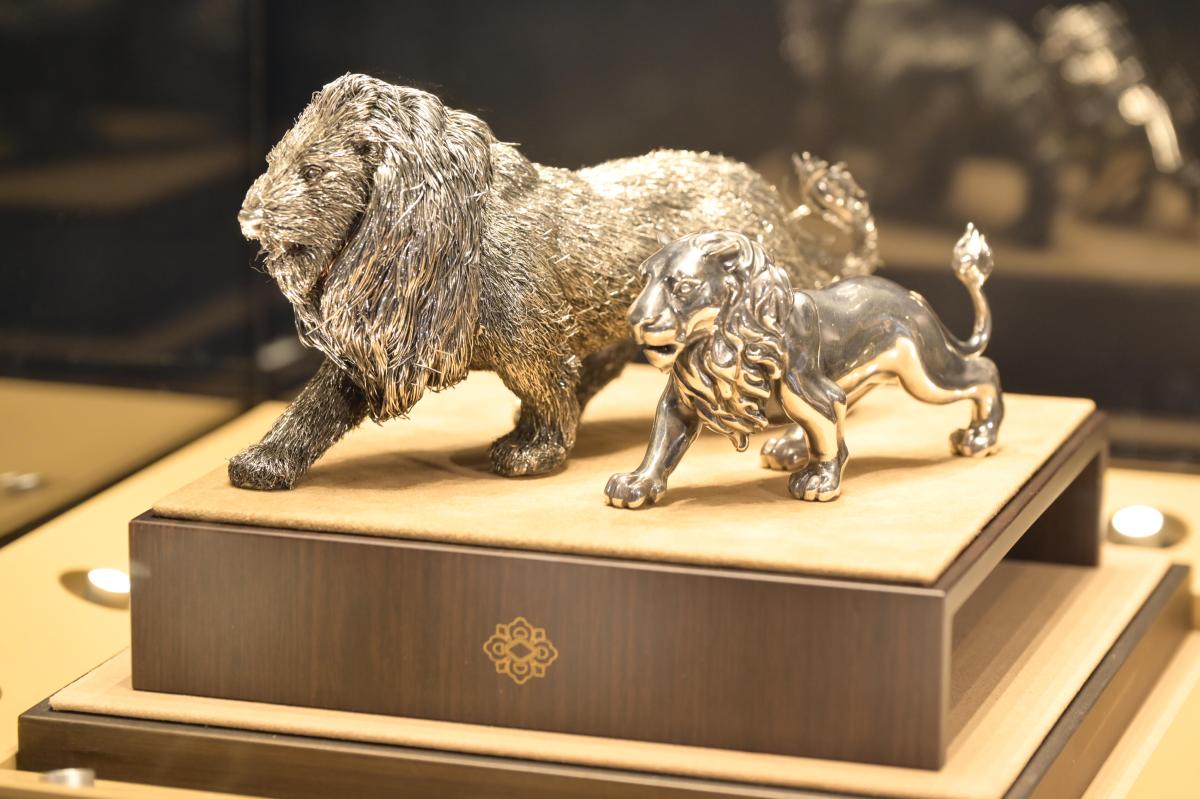
Buccellati silver lion artwork.
Luxeplace.com: How do you collaborate with artisans when designing Buccellati jewelry?
Andrea: Design drafts are often two-dimensional, but the final product is three-dimensional. So during the design process, I usually explain my designs in detail to the artisans, telling them the effect I want to achieve.
Especially for larger jewelry collections, I have to meet with different artisans at least 20 times before the work is completed.
So when I design a piece, 50% of my time is spent on the design itself, and the other 50% is spent explaining the design to different artisans.
Luxeplace.com: As a century-old brand, how does Buccellati balance tradition with innovation?
Andrea: It’s a very natural process. The eras we lived in – my grandfather, my father, and myself – were all different. If you put the Buccellati pieces designed by our three generations together, you can easily see the differences. But these differences are built on Buccellati’s style and craftsmanship.
We are very confident in Buccellati’s DNA and don’t want to change anything related to it. As I said, Buccellati’s style is unique; it attracts audiences in different ways. So what we need to do is maintain the brand’s tradition.
We don’t actually want a huge customer base, which isn’t realistic anyway. What we really want are our customers who appreciate Buccellati’s design, style, and craftsmanship. So we can’t compromise in these areas.
Luca: We often look back at the past, remembering where we came from, while also exploring the future in different ways, such as creating new collections for young customers.
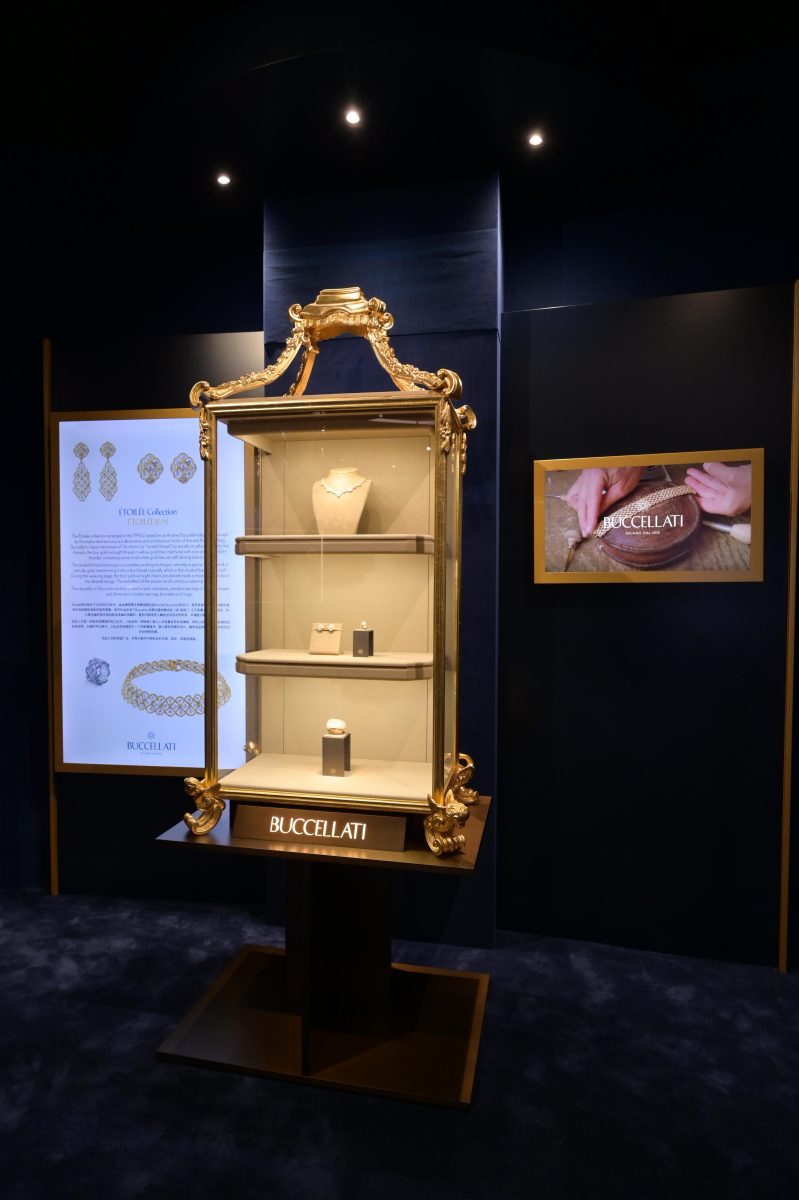
Buccellati Étoilée series works
“Everyone Used to Aspire to Work in Banking, Internet; Now Young People are Eager to Know About Craftmanship”
Luxeplace.com: For luxury brands, how can you inspire young people’s interest in craftsmanship?
Andrea: It’s easier now than before. In the past, everyone aspired to work in banks or internet companies for high salaries. But now, people are beginning to understand the importance of craftsmanship. They realize they can create things with their own hands, which is very fascinating to young people.
However, not everyone who engages in craftsmanship can commit to it for a lifetime. If you recruit 100 young people to learn, only about 20% to 25% might stay, but at least 80% will say they love what they create.
Luxeplace.com: What is the process of training an artisan at Buccellati?
Andrea: It’s a very long process. For the first 6-8 months, a young person entering the workshop needs to understand various metals and gem materials. Then, they learn from experienced artisans, doing miscellaneous work. After a year or a year and a half, they can start to work independently, learning carving techniques, etc.
Overall, it takes about 6-7 years to train a well-rounded artisan.

Buccellati artisan
Luxeplace.com: Does Buccellati have plans to increase production capacity?
Luca: First, we need to ensure that the way we make jewelry doesn’t change. We want this handmade method to continue forever.
On this basis, we are working to increase production. We have established the Accademia Buccellati in Milan, recruiting 17-19-year-olds to learn goldsmithing, gem setting, etc., and paying them a salary.
Currently, there are over a hundred artisans in Buccellati’s workshop, and we hope to double this number.
Conclusion
In Italy, a country with a long tradition of jewelry making, there are some “hidden gem” brands that are highly sought after by high-end jewelry consumers.
Even though these brands have a smaller sales scale compared to the top brands, their excellent craftsmanship, distinctive Italian design style, and centuries-old traditional techniques give them an appeal that goes far beyond their sales figures.
Buccellati is a typical example of such a brand.
Through this interview, we deeply feel that, despite over a century of history, Buccellati’s brand assets have been carefully preserved by four generations of the family. This is why it is often referred to as a “hidden gem” brand.
| Image Credit: Buccellati
丨Reporter: Zuo Xiaoli
| Editor: Zhu Ruoyu

